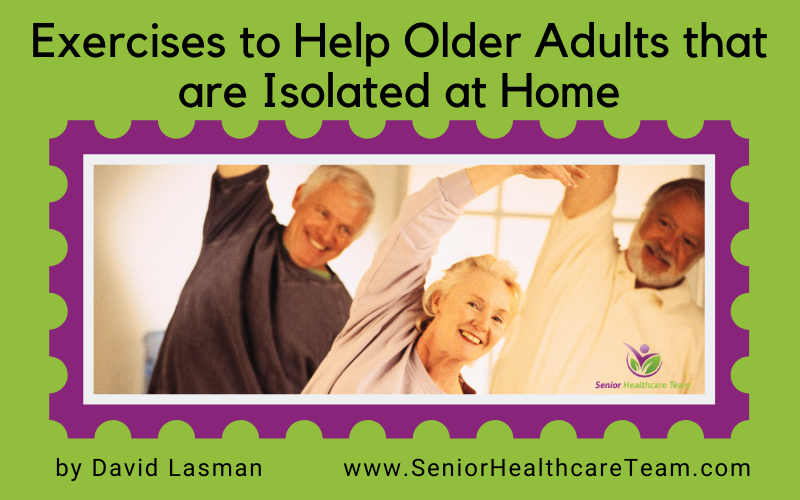While physical isolation is essential to mitigate spread of the coronavirus (COVID-19), the painful irony is that it creates a potentially devastating problem (besides the economy): sustained sedentary behavior and excessive sitting for older adults under total lock down, especially in assisted living, memory care and retirement communities.
How devastating?
Dr. James Levine, Mayo Clinic professor of medicine, famously has said: “Sitting is more dangerous than smoking, kills more people than HIV and is more treacherous than parachuting. We are sitting ourselves to death.”
With no end in sight to the lockdown, many older adults have been and will continue to be confined to their rooms for weeks or even months. The irony is that in order to stay safe from getting the virus, older adults are becoming more vulnerable to disease progression, falls and cognitive decline from spending virtually all day sitting down. And while prolonged and sustained sitting is potentially hazardous for anyone, it is exponentially so for older adults related to a myriad of health problems, including: immune system decline, muscle wasting, osteoarthritis, fall frequency, fragile skin (pressure ulcers), heart disease, diabetes, osteoporosis, chronic pain, and anxiety and depression.
The good news is that older adults can reduce their risk of harm simply by getting up a few times a day. To make this simple, I’ve developed a basic 10-minute program using only a kitchen counter.
It’s important to note that the main purpose of this program is to interrupt the cycle of sitting to reduce disease progression. To reverse progression, more challenging standing exercise is necessary. Therefore, for these movements, I’m recommending only a moderate intensity along with doctor clearance before starting.
The first movement is a tandem stance, which narrows the base of support to stimulate muscles crossing the ankles, knees, hips and trunk. This is a movement commonly used to improve balance.
The next movement is the squat, which stimulates the quads and hips, two essential muscles for balance and transfers. The position shown is the lowest a person should squat, as going deeper dramatically increases knee forces and can be very painful for those with knee osteoarthritis. Many older adults will be able to bend their knees only a few degrees, which is fine. The key to this movement is moving the hips back to start the movement so the knees don’t drift forward, which increases knee forces while reducing demand on the muscles. Special care should also be given to keeping the knees apart and avoiding them collapsing inward.
Up next is the standing plank/pushup, which stimulates the chest, shoulders, triceps, neck, abdomen, hips, hamstrings and calves. Note that level of difficulty is based on how far the person is able to walk back. Stronger people can walk back farther. Most older adults will get to the show plank position and this will be difficult enough. If not, the elbows can be bent up to 90 degrees to further stimulate the chest, shoulders and triceps. Keeping the body straight is challenging for most.
The shoulder stretch is a great movement to stretch not just the shoulders, but low back, glutes and hamstrings too. Watch hand position. If the palms are flat on the counter, this creates a potential painful position for the shoulder joints, as the space between the upper arm bone and shoulder blade shrinks, pinching tissue between them. Make sure the hands are in the position shown or even better, palms up.
The calf raise is simply pushing up on the toes as high as possible. To make it easier, lean forward.
The calf stretch feels really good, especially after prolonged sitting. Most older adults will not need to put their foot as far back as shown in the picture to get a moderate stretch.
The last movement is the march, which is intended to be a form of cardiovascular conditioning. The person should continue as long as intensity doesn’t get too high.
Finally, remember that physical distancing isn’t the same as social distancing. Calling grandparents and encouraging them to do their program — or something that’s not chair-related like gardening or cleaning — is a great way to show you care.
By David Lasman – “Ask Medicare Dave” | President – Senior Healthcare Team
wwww.SeniorHealthcareTeam.com | 866-333-7340
Selecting the right healthcare plan through Medicare can be overwhelming and downright stressful. Senior Healthcare Team is a nationwide resource that provides guidance and support about Medicare to seniors at no cost to them and helps them to choose the most suitable insurance plan tailored to their specific needs and budget. Our goal is to educate and empower our clients to make the best decisions regarding their healthcare and clear up the confusion of Medicare. At Senior Healthcare Team, we aren’t partial to any one insurance company. Our loyalty is to our clients and our mission is to provide them with the best healthcare options at the very lowest cost.

